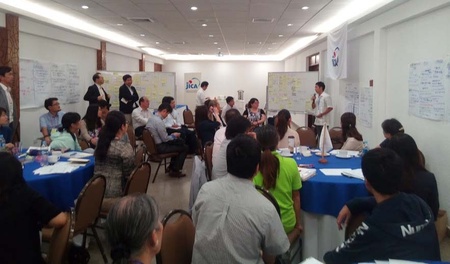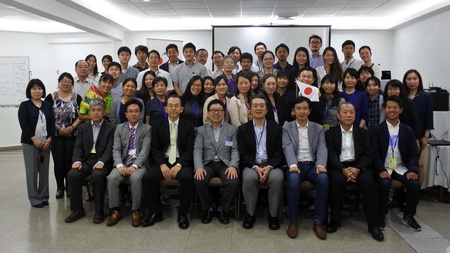Japan dispatches many cooperation volunteers to developing and emerging countries as part of its ODA (Official Development Assistance). The most well-known is the Japan Overseas Cooperation Volunteers (JOCV), dispatched by the Japan International Cooperation Agency (JICA). When it comes to developing countries, variety shows often feature the activities of current or former JOCV members. JICA also has its own support program for Japanese communities in Latin America, and there is a volunteer system for young people and seniors1 . The term of service is basically two years, and even though they are volunteers, they receive proper pre-dispatch training and various allowances, and various support is provided to make their activities in the assigned country as smooth as possible.
According to JICA statistics, as of the end of April 2017, there were 1,855 JOCVs working in 69 countries (1,062 women and 793 men, for a total of 42,599 dispatched so far). 78 volunteers (52 women and 26 men) have been dispatched to Japanese communities in Latin America as youth volunteers, and 41 as senior volunteers. The largest number of volunteers are posted to Brazil, with 62 youth and 25 senior volunteers. Other countries dispatched include Argentina, Paraguay, the Dominican Republic, and Bolivia2 .
This time, JICA conducted overseas training in Santa Cruz, Bolivia (a major city in eastern Bolivia) with the aim of supporting such young and senior volunteers. Those accepted to participate in the training were asked to submit in advance suggestions on issues related to Japanese organizations in their host country and areas that could be improved, and the on-site training included lectures and workshops given by a team of instructors, including myself. I gave a presentation entitled "The Current Situation and Issues of the Japanese Community - Towards the Challenges of Cooperation and Reform." Many of the participants were volunteers whom I had met previously in Yokohama during pre-dispatch training, and it was a long-awaited reunion, but I was able to hear directly about their various concerns and issues.3

In any case, this training reaffirmed how important it is to acquire knowledge about the Japanese communities in South American countries and the country of assignment during pre-dispatch training. In addition, knowledge of the social structure, economic disparities, and local industries of Latin America as a whole is also essential knowledge for activities in Japanese communities. As I always point out, Japanese communities differ considerably from country to country and region to region, and the activities required of volunteers are greatly influenced by their historical background, geographical and climatic factors, and industrial structure (whether it is a colonia (settlement area) centered on agriculture and livestock farming, or an urban area centered on commerce and freelance work). Whether the managers of community projects and Japanese organizations are mainly first-generation Japanese or transitioning to second- or third-generation Japanese also affects their activities. In addition, depending on the country, the government and economic and industrial policies of the time have a great influence on the industries and occupations in which Japanese communities are mainly engaged.
This time, I had the opportunity to visit the Japanese San Juan Settlement 4 and Okinawa Settlement 1 5 on the outskirts of Santa Cruz. Each settlement covers an area of tens of thousands of hectares, and is home to approximately 1,000 Japanese people. There are more than 10 times as many non-Japanese people living in the surrounding area, many of whom make a living through the economic activities of the Japanese settlements. They have made great contributions not only to the local area but also to the country of Bolivia by developing virgin forests and developing agriculture, farm industries, and related businesses, but in the future, they will need to work together with Japan to meet the needs of the local community more than ever before. To achieve this, I felt that it was necessary to work hard not only to improve the surrounding infrastructure, but also to develop the local community as a whole and to develop human resources.
I'm sure that various things can be developed through Japanese descendants not only in Bolivia, but also in other countries. JICA's volunteer program for Japanese descendants, which has a great asset of past achievements and trust, may be able to take a broader perspective and involve local people in initiatives. For example, industrial development and human resource development, which Japan is relatively good at, have their limits when achieved through on-site efforts alone, and sometimes require changes and adjustments in local national policies. For example, in Bolivia today, the high-quality rice for sushi that is grown and shipped by Japanese descendants cannot even be exported, even after the quality has been improved, because ensuring domestic self-sufficiency is given priority6 . It is important to input these reality-based contradictions before dispatching volunteers and proceed with their activities.
For young and senior volunteers, working in Japanese communities is a big challenge. Even within the same country, you may have to take completely different approaches depending on the region and place of settlement. Sometimes the hints and know-how of other colleagues do not work very effectively. Japanese communities in Brazil and Peru are mainly made up of third-generation Japanese, a generation that knows little about Japan or the immigration history of their predecessors. However, as they are the generation that has the greatest understanding of the local community, it is also true that they have flexible and bold ideas. There is also no doubt that the management and business development of Japanese organizations is seeing more cooperation and collaboration with local communities and non-Japanese than ever before.
On the other hand, even if they have stayed in Japan for study abroad or training, or because their parents worked, they may not have a strong understanding of Japanese society or systems. Also, simply dividing them into generations and trying to understand them does not necessarily mean much. On the contrary, there are many first-generation Japanese who listen to the requests of young people, engage in advanced activities, and have high management skills and ambition, but on the other hand, there are many second- and third-generation Japanese organizations that have closed minds and do not have a good atmosphere.
Another important purpose of the volunteers is not only to provide support to the Japanese community, but also to foster sympathy for Japan and true knowledge of Japan. When assigned to a post, they are very happy if they simply bring along a textbook used in Japanese high schools and lecture on its contents. Even among Japanese people, many do not understand much about Japan, and even more so among non-Japanese people, many have incorrect information about Japan. There is no need to force knowledge on people, but it is still an important role of the volunteers to answer questions about Japan properly when asked.
As was emphasized during this overseas training, in order to strengthen cooperation in the future, we must build relationships of trust with various Japanese descendants individually with a long-term perspective. Furthermore, in order to develop this "cooperation," we must more strongly appeal to the local community as a whole that the benefits of JICA's projects are being conveyed. In fact, public relations activities have become more noticeable in recent years, but we need to get more coverage from the local general media. The activities of each Japanese volunteer are small, but when they are noticed, expectations rise and people who are willing to cooperate gather. If we can send as strong a message as possible that "we accomplished this together, with the cooperation of the local community," the effect will be greater.
The presence of JICA Japanese community volunteers in Japan provides some inspiration to the Japanese communities in the areas where they are assigned, and sometimes serves as an opportunity to initiate new activities or reexamine previous activities.
It seems that this overseas training enabled the participants to share various issues and awareness, but in the future it will be important for them to learn from the know-how of senior volunteers and to cooperate with colleagues who are working at the same time.
As a new possibility for volunteering in the Japanese community, it seems likely that in the future, children of Japanese descendants from South America who do not have Japanese nationality will also be eligible to be dispatched, but for these people, pre-dispatch training and orientation will be even more important than before. In many cases, they do not know their home country (their parents' country) or have only a fragmented image from their childhood (sometimes a bad image), and in some cases they do not have a very positive view of their parents coming to Japan to work. In order for these people, who do not have a good understanding of the historical background or the circumstances of their families, to be able to do a good job at their assigned place, it seems that they will need more detailed preparation than other Japanese volunteer candidates. Even if they have some language ability (Spanish or Portuguese) in the country or region where they are rooted, the demands from the host country will surely be stricter. When Japanese descendants support Japanese descendants in South America or promote cooperation through volunteer work, sometimes the selfish intentions of both parties may intersect, and the results may be disappointing. To prevent this, it is preferable for volunteers to not only have received higher education (vocational school or university) in Japan, but also have some practical experience as members of society. This will also be a new challenge for Japan.
This wonderful cooperation program by JICA is a great opportunity for the volunteers to hone their human skills in their own lives. The selected volunteers must raise their awareness and deepen their knowledge from the pre-dispatch training stage, and think about how they can utilize their skills in the place of their assignment, and how they can make the people in their place of assignment happy and appreciated. At the same time, they must be proactive in the field without fear of failure. In Latin society, the ability to appeal to others is also an important factor. And when they return to Japan after successfully completing their term of assignment, they may become indispensable human resources in any field in today's inward-looking Japan. From there, a new challenge begins.
Notes:
1. JICA's volunteer system
JICA Volunteer Program Overview
JICA Volunteer Project Track Record / Dispatch Track Record
2. The cumulative total of youth volunteers in the Americas is 1,352 (518 men and 834 women), and 502 senior volunteers.
3. Before being dispatched overseas, both the Japan Overseas Cooperation Volunteers and the Japanese Community Volunteers undergo a very tight schedule of two and a half months of language training and general knowledge lectures.
4. The distance from Santa Cruz to the settlement is 138 km, and it takes 2.5 hours by car. It has a hot and humid subtropical rainforest climate. 87 people settled here in July 1955, and there are currently 250 households and a population of about 800 people.
5. The Okinawa Settlement began with the relocation of people from the Uruma Settlement in 1954, and in 10 years 678 households and 3,229 people settled there. There are three Okinawa Settlements, the First, Second, and Third, and the combined current population is just under 1,000. For economic reasons, many people have relocated to Brazil or Argentina. The total area is 47,000 hectares.
6. In the Japanese settlements, rice cultivation is thriving, and they grow high-quality rice for sushi. Because they cannot sell it in the domestic market alone, they try to export it to neighboring countries, but exports are prohibited because food self-sufficiency is a priority.
© 2017 Alberto J. Matsumoto








